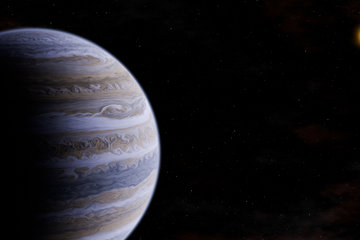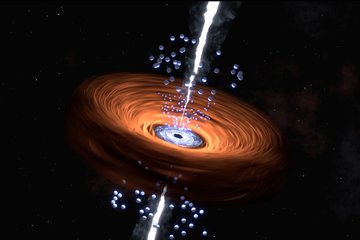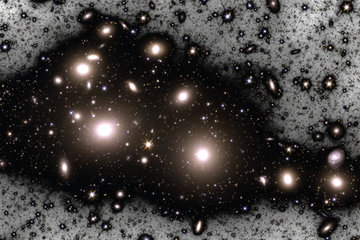MeerKAT+: the MeerKAT Extension
The handover of the first dish of the MeerKAT extension signals an important milestone for the SKA-MID construction
Wednesday, 21 February 2024: The first MeerKAT+ antenna was today handed over in a festive ceremony in the Karoo region in South Africa. This marks another important step towards the SKA Observatory’s (SKAO) mid-frequency telescope, into which the 14 antennas of the MeerKAT extension will be integrated in the next few years. In addition to representatives of the members Max Planck Society (MPG), the South African Radio Astronomy Observatory (SARAO) and the Istituto Nazionale di Astrofisica (INAF) which are jointly financing these 14 antennas, invited guests from the partner countries involved and the SKAO took part in the handover ceremony.

In their welcoming remarks, Angus Paterson, Deputy CEO of the National Research Foundation in South Africa, Takalani Nemaungani, Chief Director for the Astronomy portfolio of the Department of Science and Innovation, Enrico Brandt, Deputy Ambassador of the German Embassy in South Africa, and Michael Kramer, Director at the Max Planck Institute for Radio Astronomy in Bonn, Germany, highlighted the importance of the event for the future of radio astronomy.
Together with Pontsho Maruping, Managing Director of the South African Radio Astronomy Observatory (SARAO), Michael Kramer addressed the development of the MeerKAT extension (MeerKAT+) antenna and the excellent collaboration throughout the entire process. “It is incredibly impressive to see what has already been achieved with the MeerKAT telescope, and even greater results could be expected with the expansion,” he said. The highlight of the ceremony was a trip to the antenna field, where the MeerKAT+ antenna was officially handed over by Fabrice Scheid, Managing Director of OHB Digital Connect.
The expansion of the MeerKAT telescope will further deepen the scientific and technological cooperation that has already begun through the close collaboration between SARAO and the Max Planck Society (MPG) in Germany as part of MeerKAT. "The project has started only in 2019 and it is great to see that the first successes of this joint project are now visible," said Pontsho Maruping, adding that "The MeerKAT+ expansion project will significantly improve the sensitivity, angular resolution and image quality of the MeerKAT radio telescope.” The expansion of MeerKAT’s 64 parabolic antennas by at least another 14 dishes will result in a huge virtual telescope that can produce detailed radio images from the observation of weak radio sources.
These capabilities will grow even further when the MeerKAT antennas become part of the huge 197-dish SKA-MID telescope array, currently under construction at the same site.
"The expansion of MeerKAT increases the sensitivity of the receiving systems by around 50%, enabling not only much faster mapping of the sky but also the detection of extremely weak astronomical sources," said Angus Paterson. Dennis Winkelmann, Managing Director of industry partner OHB Digital Connect, was satisfied with the result: "We have proven that the design is excellent, that it works for scientific use and that it is suitable for serial production on an industrial scale."
"This project is another example of the excellent and trusting cooperation between SARAO and MPIfR," said Michael Kramer. "It is fantastic to see this first MeerKAT+ antenna being completed. This is an achievement of partners from science and industry, nationally and internationally. And I can’t wait to see the first data from the antenna along with the rest of the array."
Background Information
MeerKAT: Built and operated by the South African Radio Astronomy Observatory (SARAO), the 64 dish MeerKAT is the largest radio telescope in the Southern hemisphere and one of two SKA precursor instruments based in South Africa. Located in the Karoo semi- desert, the radio telescope will soon be expanded with an additional number of dishes, in the context of the “MeerKAT+” project, jointly funded in 2019 by SARAO and the Max-Planck- Gesellschaft (MPG) in Germany and since 2020 with the Istituto Nazionale di Astrofisica (INAF). The telescope will later be gradually integrated into SKAO's Mid telescope in South Africa.
SARAO: The South African Radio Astronomy Observatory, a facility of the National Research Foundation, is responsible for managing all radio astronomy initiatives and facilities in South Africa, including the MeerKAT Radio Telescope in the Karoo, and the Geodesy and VLBI activities at the HartRAO facility. SARAO also coordinates the African Very Long Baseline Interferometry Network (AVN) for the eight SKA partner countries in Africa, as well as South Africa’s contribution to the infrastructure and engineering planning for the Square Kilometre Array Radio Telescope (SKA).
MPG: The Max Planck Gesellschaft is a non-profit organisation with 86 institutes and research facilities. Among the society’s institutes is the Max Planck Institute for Radio Astronomy (MPIfR) as a key player in the SKA’s Dish engineering consortium. Together with German industry partners, such as the telescope antenna specialists MT Mechatronics (MTM), and international partners, the Dish consortium is responsible for designing the SKA’s mid-frequency array (SKA-Mid).
SKAO: The SKA Observatory (SKAO) is an intergovernmental organisation bringing together nations from around the world. Its mission is to build and operate cutting-edge radio telescopes to transform our understanding of the Universe, and deliver benefits to society through global collaboration and innovation. The Observatory has a global footprint and consists of the SKAO Global Headquarters in the UK, the SKAO’s two telescopes at radio- quiet sites in South Africa and Australia, and associated facilities to support the operations of the telescopes. Once in operation, the SKAO will be one global observatory operating two telescopes across three continents on behalf of its member states and partners.
INAF: The Istituto Nazionale di Astrofisica is the main Italian research institute for the study of the Universe, founded in 1999. INAF funds and operates seventeen separate research facilities, which in turn employ scientists, engineers and technical staff. The research they perform covers most areas of astronomy, ranging from planetary science to cosmology.












